Active Fishing Gears
Active Fishing Gears
Active gear has to be moved, dragged or towed to capture fish. This usually requires engine-propelled boats and usually involves additional investment over passive or stationary gear.
Fishing hooks
Line fishing consists of a line and a hook. Hooks are made of galvanized or aluminium coated iron, brass and stainless steel. They are manufactured in different shapes and sizes. In addition to simple hooks, hooks of more complicated designs such as double hooks, triple hooks, and jigs are also in use.
- A simple hook consists of a head or eye, by which it is connected to the line, shank, bend, point, and barb.
- Barbless hooks are used in pole and line to facilitate easy removal of fish.
- Kerbed hooks which are twisted in the bend part make the baiting easier and increase efficiency.
- Double hooks or triple hooks are used in troll line with artificial baits. These hooks hold in fish more securely than the single hook.
- Jig hooks have a single or double whorl of barbless hooks around spindle shaped coloured /metallic/plastic body.
Size of the hook is denoted according to numbering system followed by the different manufacturers. Size of the hook varies inversely with the number of hooks. Mean selection length of the fish caught is proportional to the size of the hook represented by its breadth. Smaller hooks are reported to have higher catching efficiency.
Parts of hooks
Hooks are of different types, shapes and sizes. These are made of steel and wrought iron. Wrought iron is commonly used. The fish hook is fastened to a line for the capture of fishes. The principal parts of a hook are eye, shank, bend, barb and point.
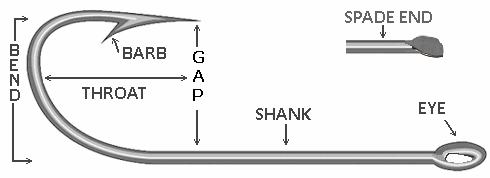
Parts of a fishing hook
- Purpose of the eye is to attach the hook to the line. There are various types of eyes to facilitate easy attachment.
- The shank follows an eye. Shanks are given different shapes and length, depending upon the fish caught.
- Bend is next to the shank. There are various types of bends. The shapes and size of the bends will vary depending upon the fish to be caught.
- The function of the barb is to prevent the escape of fish from hooking. There are hooks without barbs. Barbless hooks are used for catching tuna by pole and line. The point of the hook is given different shapes.
- Point is the part which pierces into the mouth of the fish. The fish caught may try to escape after hooking. During struggling the single hook may be straightened, helping the escape of fish. If double hooks are used, the hooking is at two different portions of the fish and hence the chance of escape is less.
Numbering of hooks
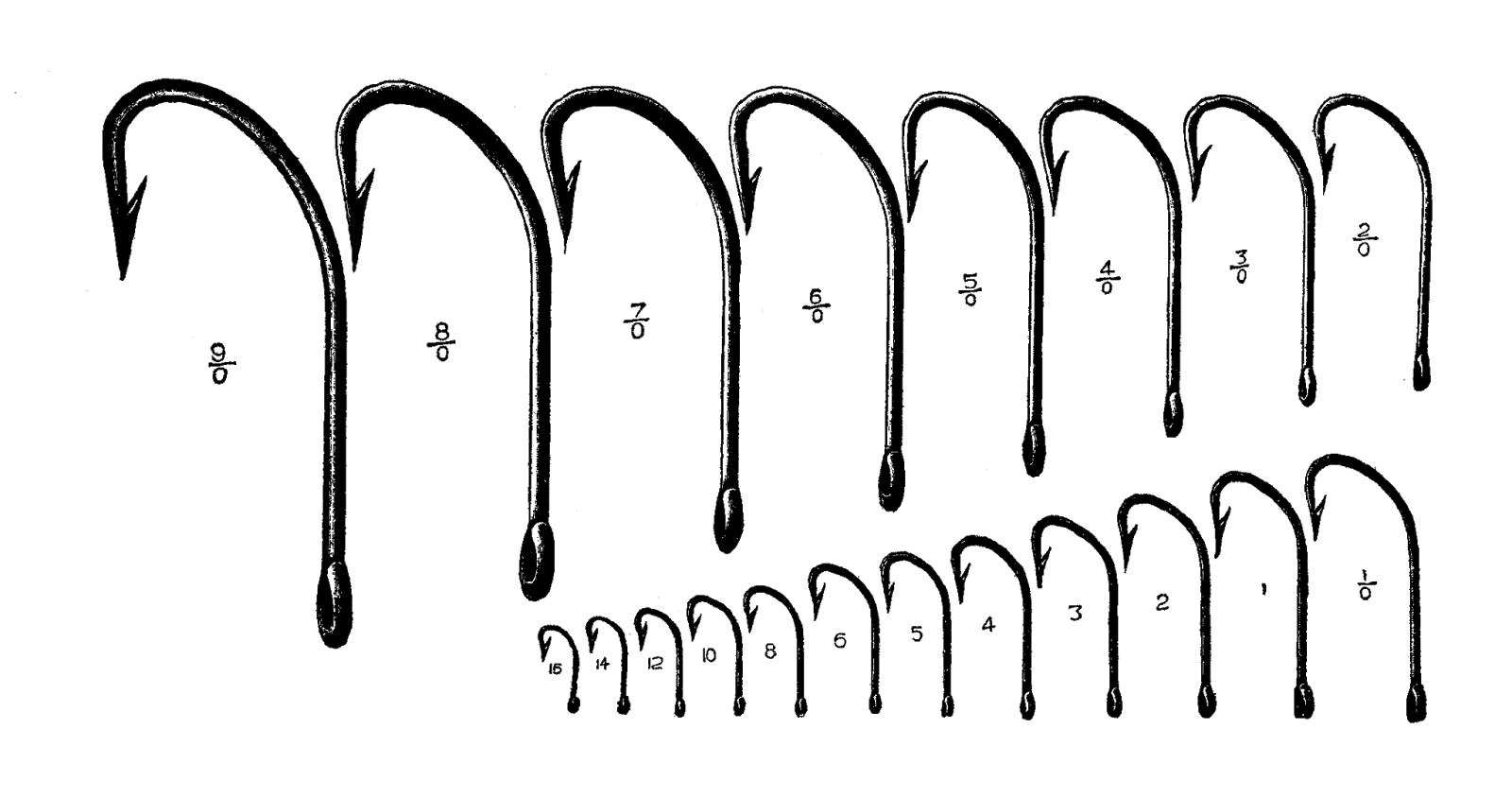
Norwegian method is followed for numbering of hooks. The size of the hook becomes smaller as the number increases. Also, the length of the hook, the diameter of the shank, the radius of the bends, etc. are also important.
Artificial baits or jigs
Artificial bait
These types of artificial baits are more effective for catching swift swimmers, feeding on small moving animals. These artificial baits attract fishes either by their shape, colour or by their reflection. In troll lines, the attraction is not only due to appearance but also by their movement similar to those of exhausted prey. Tin, lead, brass, horn of oxen and buffalo, whale bone, feather with different colour, plastic fishes and squids, etc. are used as artificial baits. These are mainly used to catch slow-moving fish that are spawning.
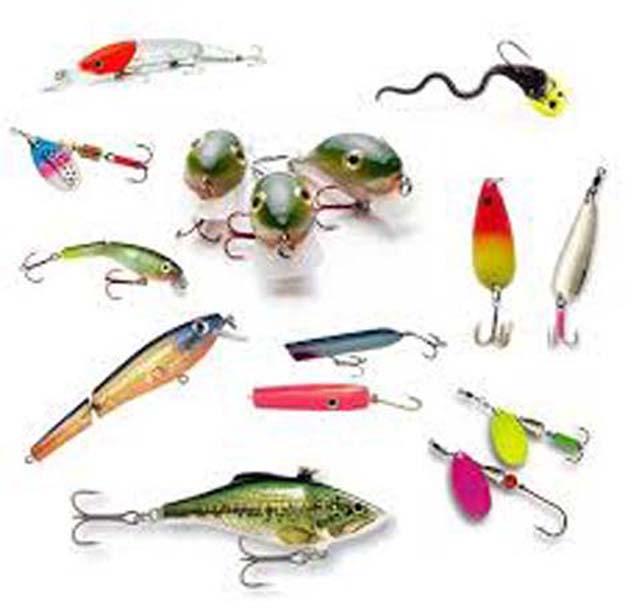
Jigging
The jigging technique involves mainly catching fish by impaling them with special hooks. In jigging, the line must be jerked to pierce the fish. The sharp hooks are weighted so that when they are pulled up, there will be sufficient momentum to penetrate the fish. In some cases, regular baited hooks are jigged manually or mechanically to attract attention to the bait. Special reels can be used to impart a jigging action to the line.
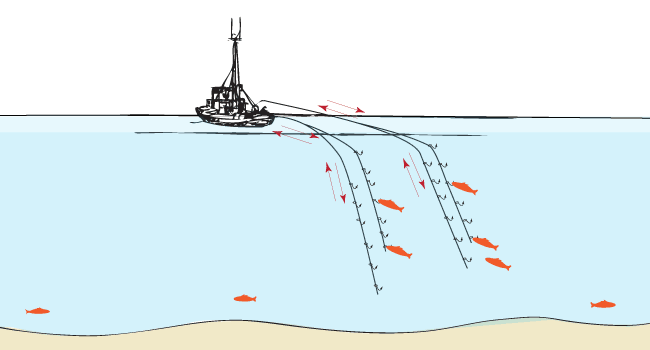
Trolling lines
Trolling lines are simple hooked lines that are trailed from a moving vessel at a controlled depth. Bait may be artificial or natural and attracts predator fish that see what appears to be a smaller fish thrashing and turning in the water. The lure may be nothing more than a colourful piece of cloth, a small bunch of feathers, or a piece of skin from the bait fish, but it must be carefully adapted to local conditions and fish species and size. The use of outriggers can increase the number of lines that can be trolled and helps keep them from becoming tangled.
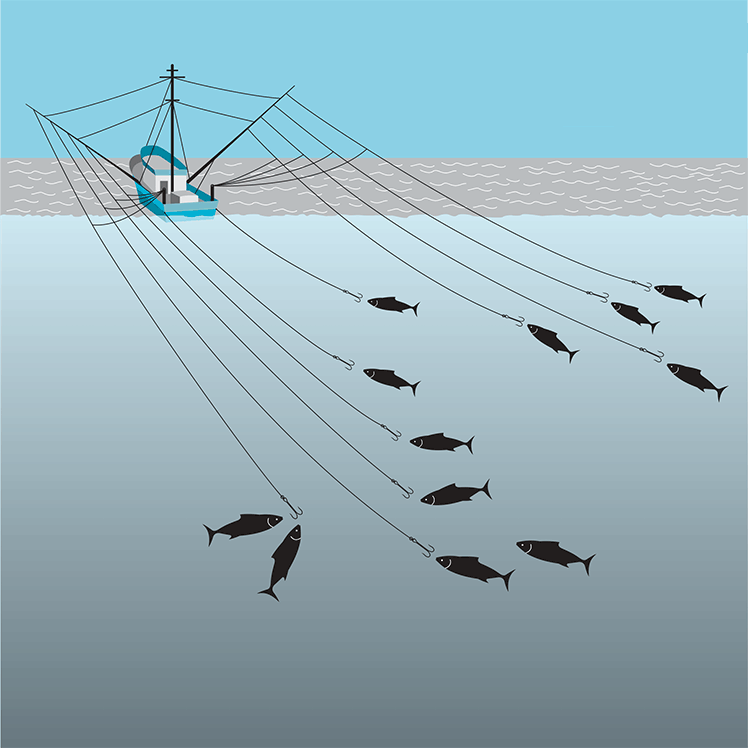
Trolling offers numerous advantages to small-scale fisheries. Multiple trolling can be performed from a reasonably small craft. Changing sinker weights allows fishing at graduated depths. Lures can be made of local materials and easily changed for the target species. The use of artificial bait avoids the capture or purchase of live bait.
Trolling is also an excellent auxiliary method and can be used as the vessel is going to or returning from other fishing grounds. It’s mainly used to capture the pelagic or demersal species and are eligible to operate in the inshore or offshore waters. To introduce this does not require high skills or the massive investment as in a gear.
Seining
Seines are long nets with meshes small enough to prevent the desired fish from gilling (filtering nets). They are set in a semi-circle and dragged over a smooth bottom using long ropes (sweeps). In this way, the fish are herded into the net and hauled onto the beach or on board.
Beach seines are especially appropriate for catching seasonal pelagic species as they feed near shore. They are most often set from the boat. One end remains on shore, while the rest of the net shall be fixed in a curved path and brought back to the beach. Beach seines are especially appropriate for catching seasonal pelagic species as they feed near shore. They are most often set from the boat. One end remains on shore, while the rest of the net shall be fixed in a curved path and brought back to the beach.
Large beach seines, however, are costly, and their use is restricted to large stretches of smooth, shallow bottoms with fairly mild surf. The net is species-indiscriminate and may catch juveniles of large-sized fish. Small two-man beach seines are often used for catching live bait or small fish. These tend to have a uniform small mesh. Beach seines have the potential for increased motorization and mechanization. Shore-anchored pulleys, tractors, jeeps, or even animals could be used to make hauling easier.
The Seine which is operated from the boat is called boat seine. Boat seines have the potential of bringing small-scale fishers to previously unexploited resources. However, any introduction of modern technologies (motorization of the boat, rope and net haulers, storage of nets and cables on reels) that would enlarge the area covered and could increase the catch involves capital investment and an increase in running costs. An example is a Rampani net operated in south west India.
Trawls
Trawl net is conical bag nets with two wings and codend where the catch is concentrated, performed by towing from one or two boats. The size of a trawl net may be defined by the length of the foot rope, headline or the number of meshes around the fishing circle, and the mesh size at that point. Mesh sizes are usually at their largest in the mouth of the trawl and progressively reduce towards the codend. Based on the operational position it is categorized into bottom trawl, midwater trawl or pelagic trawl.
Bottom trawling
When a trawl net is dragged in the bottom or just above the bottom, it is known as bottom trawling. Stern bottom trawling was first introduced in the late 1940s and has become widely popular since then. The advantages of stern trawling is the maximum utilization of the towing power and ability to set gear in straight line.
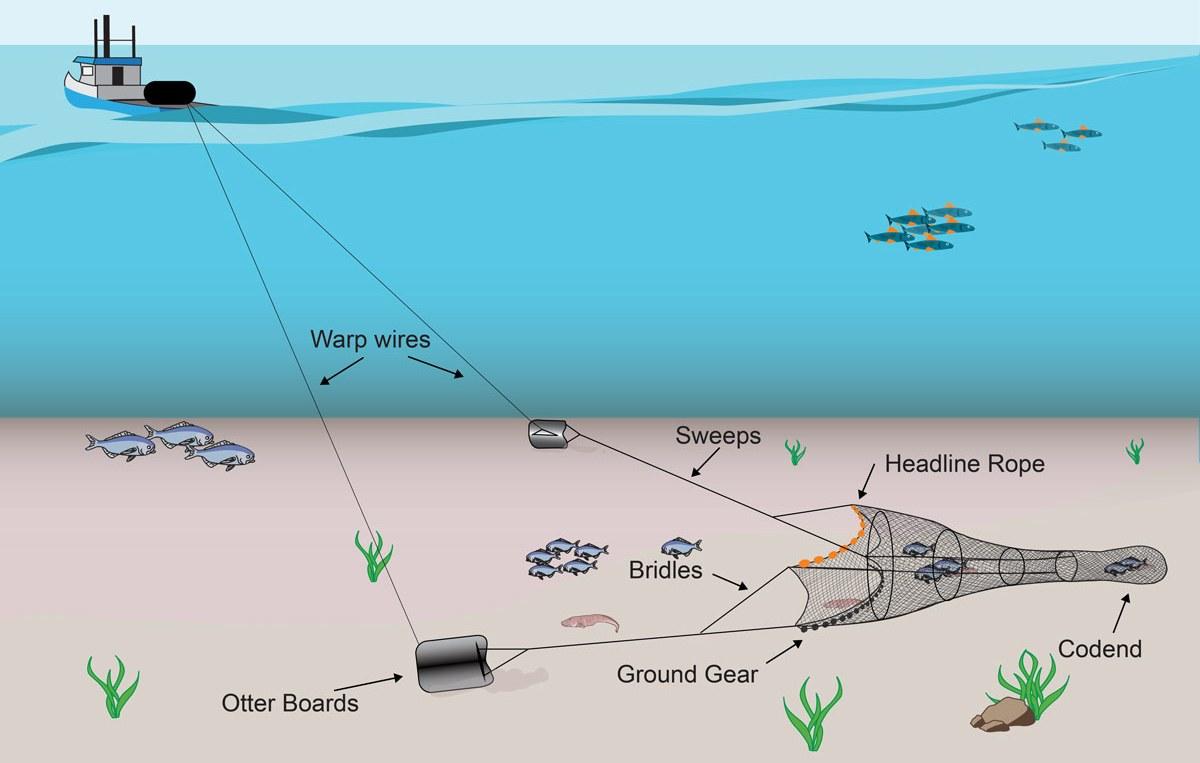
Mid water Trawling
Mid water trawls are used for pelagic trawling. These are conical bags with a wide mouth made of light netting yarns and large meshes. Based on the construction of the trawls, they can be grouped into
- Two seam pelagic trawls
- Four seam trawl (with all the four equal panels for pair trawling)
- Four seam trawl (The upper and lower panels are identical, and the two identical side panels are narrow)
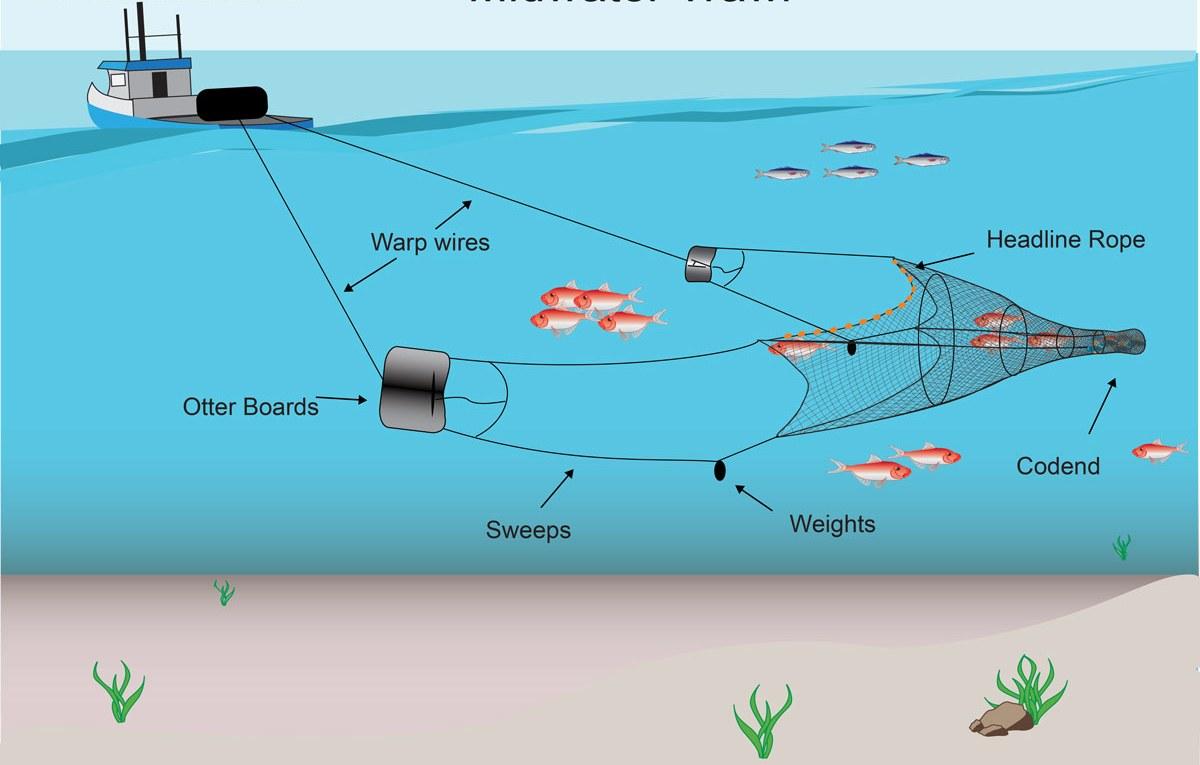
Surrounding net
Surrounding nets are rectangular walls of netting rigged with floats and sinkers which after detection of the presence of fish are cast to encircle the fish schools. Surrounding nets are typically operated in surface layers.
The purse seine is the foremost type of surrounding net, in which bottom of the net is closed after encircling the fish school, by a purse seine line which prevents fish from escaping downwards by diving. It is categorized in based on the fishing boat as one-boat and two boat purse seiner by fishing boat. Based on the target species there are anchovy purse seine, sardine purse seine, mackerel purse seine, cod purse seine and tuna purse seine. Besides, based on the scale of operation is categorized into small, medium and larger purse seiner. Surrounding net without purse line like lampara net is operated at the small-scale level.
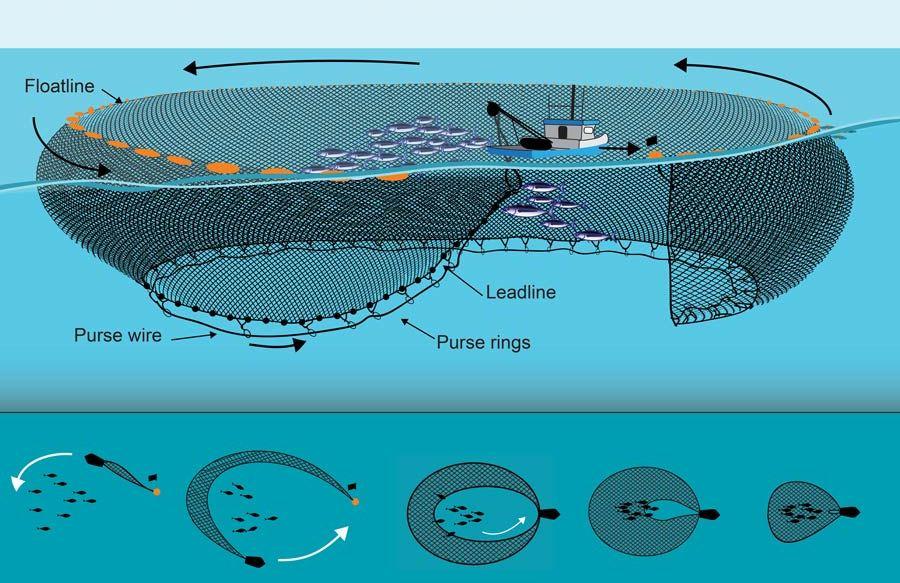
Lift net
Lift net consists of horizontal netting panel or a cone shaped bag with the mouth facing upwards, which are submerged and lifted either manually or mechanically to filter the fish overlying water column. It is categorized into shore operated and the boat operated. The shore operated lift net is operated from permanent installation along the coast. The boat operated lift net which is operated from one to several boats.
Boat operated lift net
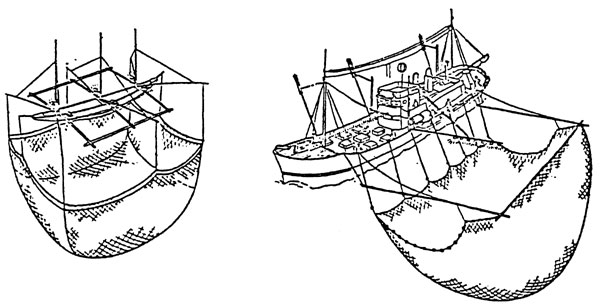
Shore operated lift net
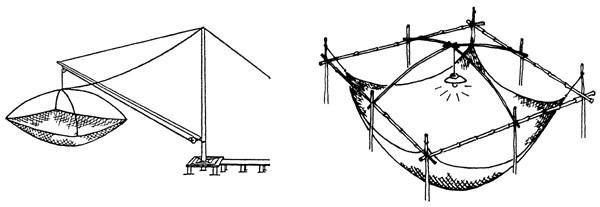
Sources
- Badapanda, K.C. 2013. Fishing Craft and Gear Technology: Basics of Fisheries Science, Volume 3. Narendra Publishing House, New Delhi.
- Hanumanthappa, B. and Neethiselvan, N. Fishing and Gear Technology.
- Meenakumari, B., Boopendranath, M. R., Pravin, P., Thomas, S. N., and Edwin, L. 2009. Handbook of fishing technology. (Ed.). Central Institute of Fisheries Technology, Cochin.
- Sreekrishna, Y. and Shenoy, L., 2001. Fishing gear and craft technology. Indian Council of Agricultural Research, New Delhi.
Last Modified : 7/1/2024
